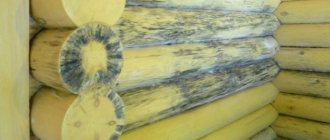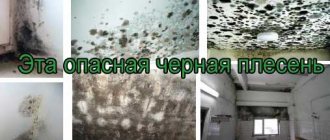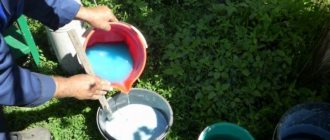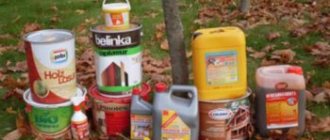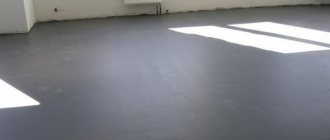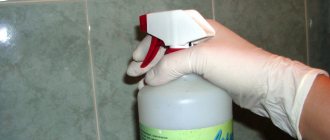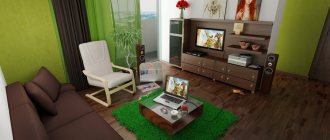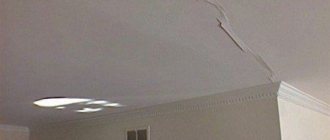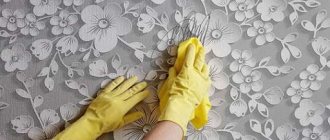Products designed to eliminate black stains on the wall are represented by a wide range of different solutions. The main thing is to know what to do to remove troubles and how to treat stains on the walls.
Black or blue growths have appeared in the room, the walls are peeling and crumbling - these are symptoms of the appearance in the house of an enemy of comfort and a lover of moist air - mold. To remove fungi, you will need to perform a whole range of work using industrial and folk remedies.
To successfully combat this nuisance, you need to know what you have to “fight” with.
Causes of fungus
To understand how to treat walls against mold or mildew, you first need to understand what these formations are. What types there are, knowing the problem will help you detect it faster and take appropriate corrective measures.
To prevent a problem from occurring, you should understand what is causing it. There are four main reasons that contribute to the appearance of mold and fungal formations on surfaces at home:
- Increased humidity levels;
- Lack of good ventilation in the room;
- Faulty operation of heating devices;
- Plants when their number is large.
To understand how to eliminate the reasons, each will be discussed in detail below.
To prevent a problem from occurring, you should understand what is causing it.
High humidity
Treating walls against mold and mildew will not have a lasting effect if the increased level of humidity in the room remains. Typically, this problem occurs in the bathroom and basements. The presence of leaks in the plumbing or heating system contributes to increased humidity.
Also, if condensation appears on the windows, the humidity increases. If these flaws are eliminated, the ideal conditions for mold formation will disappear.
If condensation appears on the windows, the humidity increases.
Poor ventilation
You can destroy harmful formations, but if the ventilation in the room is poor, the problem will arise again. The lack of an effective ventilation system leads to increased humidity. Accordingly, an ideal environment is created for the occurrence of mold and fungal deposits on the surface. It is necessary to systematically check the ventilation grilles; if necessary, remove dirt from them, then the air will flow freely.
It is necessary to systematically check the ventilation grilles and, if necessary, remove dirt from them.
Heating problems
If the heating system in a building does not work well, sudden temperature changes occur. And this leads to the appearance of condensation on the surface. After some time, a fungus will appear in these areas, the spores of which will quickly spread along the walls, creating an unsafe environment for human health.
If the heating system in a building does not work well, sudden temperature changes occur.
A large number of plants
Not only does mold appear on walls and other surfaces in the home, but it can also be regularly seen in potted plants. The reasons for this phenomenon may be:
- Too frequent watering;
- Low room temperature;
- There is no drainage, so water can accumulate in the soil;
- Increased acidity level in the soil.
If there are many plants with similar formations in the building, then over time fungus will also form on the walls and ceiling.
Not only does mold appear on walls and other surfaces in the home, but it can also be regularly seen in potted plants.
Professional disinfection methods
Today, the Moscow SES, which works effectively in this area, uses modern technologies that make it possible to quickly and permanently remove or destroy the most dangerous mold.
1) Hot fog.
The above disinfection method allows you to form a hot cloud of chemicals with a powerful penetrating and destructive effect, quickly getting rid of mold in places where it spreads.
2) Cold fog.
This method is characterized by the formation of a jet of cold steam, which in its characteristics is in no way inferior to the first fumigation option. Cool mist is just as effective at killing mold and mildew.
3) Wet disinfection.
In this case, specialists use liquid chemicals. They are very effective in fighting mold. Highly qualified specialists very successfully use chemicals in different doses and proportions.
4) Carbonation.
Gas treatment leaves mold no chance. This technology creates clouds of chemically active substances that fill the entire room and attack and destroy mold spores.
What is fumigation?
A residential building or apartment undergoes professional treatment and mold removal using innovative techniques. The most well-known mold removal technique is fumigation.
Fumigation in Latin is the fumigation of various harmful creatures and parasites for the purpose of their subsequent poisoning with poisonous gases using special devices (fumigators). Be careful!
Its essence is to create a cloud of chemicals that can penetrate into any crevice in a house or apartment and destroy the infection. Fumigation is also used for disinsection and deodorization of any room or territory.
During fumigation, specialists install barriers that protect a house or apartment from the reappearance of mold on already treated surfaces, preventing this serious threat to human life and health.
What types of fumigants are there?
A fumigant is a chemical substance that penetrates into spores or mold and leads to the elimination of these parasites. Some fumigants boil at room temperature, while others have a higher boiling point.
Fumigants are available in tablet or powder form. When interacting with moisture, they can release certain gases that have a negative effect on parasites. These fumigants are stored in sealed cans.
Individual fumigants must be heated using a fumigator. As a result, they take on the form of a gas, penetrate the mold and kill it along with the spores. Only qualified specialists have the right to work with such substances.
Sometimes, for disinfection purposes, a special chamber is used in which individual household items affected by spores or mold fungi are processed in a closed space.
Recommendations after fumigation
After treatment for mold and mildew, experts strongly recommend that their clients get rid of all conditions that contribute to its appearance as soon as possible, otherwise the mold will return:
- From time to time it is necessary to ventilate the home;
- thoroughly clean the ventilation system, etc.
Professional processing is obviously against amateur performance. Practice shows that in the second case, parasites perfectly adapt even to very strong drugs and become more tenacious.
It is more profitable to invite specialists already in the first season of the battle against mold. After the first session you can see a successful result. This is an order of magnitude better than doing home treatment for mold at home.
Next, it is recommended to carry out cosmetic repairs in a mold-free house or apartment, because Some surfaces may be damaged during disinfection and lose their presentation.
Types and harm
Treatment for mold may vary depending on the type of mold. There are several types of mold that can often be found indoors. When choosing a remedy for mold and mildew on the walls, you need to take into account the characteristics of the formation, then you can effectively eliminate the problem.
When choosing a remedy for mold and mildew on the walls, you need to take into account the characteristics of the formation.
White
This type appears on the vegetation available in the house. Most often, flowers, shoots, root systems and plant soil are affected. At first it appears as a cobweb-like coating on pottery, a small coating quickly spreads and the cobweb becomes thicker.
It is not difficult to fight this species; if the plant cannot be cured, then it should be removed from the room and the fungus will not spread further. The presence of white mold near a person can cause an allergic reaction.
Most often, flowers, shoots, root systems and plant soil are affected.
Black
The black type of mold is the most harmful to humans. Usually its appearance occurs behind damp and warm objects; such an environment is well suited for formations.
Typically, affected areas appear in the bathroom, or in pieces of furniture in rooms with frequent changes in temperature. All of the factors described can be the cause.
Staying in a room with a damaged surface for a long time leads to an increase in the incidence of colds among residents. Over time, overall immunity decreases and chronic diseases may occur. It especially quickly affects the health of children.
The black type of mold is the most harmful to humans.
Yellow
Yellow mold most often appears in basements where humidity levels are high. It can settle in food, releasing the poison aflatoxin, which can withstand cooking.
Formations may appear in other rooms, on washing machines, dishwashers, air conditioners and other places with an intensely humid environment. Spread occurs quickly in such conditions.
Yellow mold most often appears in basements where humidity levels are high.
Green
It usually appears on food products that have already expired. Do not consume affected food; ingestion may cause negative health effects.
Green mold may also appear on bricks, wood, and other building materials.
Do not consume affected food; ingestion may cause negative health effects.
Pink
This type is not as common as black, but its danger is also high. It is common to see pink formations between the tiles in the bathroom. It may appear on linen and building materials. For the latter, their presence leads to destruction. Using linen with mold leads to stomatitis, mycosis, thrush, and dermatitis. It is also harmful to the lungs and respiratory tract.
It is common to see pink formations between the tiles in the bathroom.
Spoiled aesthetics and more
Dark spots of fungus will appear in the future on the wallpaper.
Penetrating deep into building materials, they begin their destructive activity. Dark spots on the wallpaper, gray-green stains on the walls, an unpleasant slimy or shaggy surface of the affected areas are unlikely to add aesthetics to your interior.
At the same time, being in the vicinity of such representatives also does not bode well for the health of the apartment’s inhabitants - allergies, asthma and other diseases can be caused by these tiny living organisms.
Their distinctive feature is their reproduction by spores. Spreading with dust throughout the house, these spores fill all its corners. Once on the skin, mucous membranes or in the respiratory tract, they become a source of allergens and toxins.
As a result, after mold and mildew appear in a house, all its inhabitants may sooner or later become patients of an allergist, dermatologist or ENT specialist.
The best drugs for mold and mildew
Remedies for fungus and mold are produced in a variety of ways, depending on the composition, determine for what, their use will be effective. Antiseptics can have different degrees of protection; the choice is made based on the base material and the type of fungus.
Remedies for fungus and mold are produced in a variety of ways, depending on the composition, determine for what, their use will be effective.
Antifungal spray
The presence of a sprayer simplifies the process of applying the drug; there are many similar options on the market. The following popular mold remedies can be distinguished:
- Anti mold Dali brand;
- Fungicide Alpha;
- Stop mold Olympus;
- Bitol spray;
- Special checkers.
When choosing, focus on:
- Horizontal or vertical surface will be processed;
- Type of base – concrete, brickwork, etc.;
- Type of fungal formation.
The operating instructions include the protection with polyethylene or cloth of surfaces that will not be treated so that chemicals do not get on them.
The master must wear protective clothing, a respirator, and gloves.
The presence of a sprayer simplifies the process of applying the drug; there are many similar options on the market.
Antiseptic anti-mold in solution
Anti-mold for walls is used in the form of solutions as standard if the treatment area is large. Then a large volume of the drug is purchased in order to efficiently remove moldy manifestations.
Manufacturers prepare the solution immediately suitable for application. For better treatment, use a sponge dipped in impregnation to remove a layer of mold. Usually no more than two applications are required.
Prevention can be done by washing surfaces with water and a solution.
For better treatment, use a sponge dipped in impregnation to remove a layer of mold.
Antifungal removing primer for unfinished concrete walls
A primer with antiseptic properties is also suitable for this process. They are produced by many companies. Milkill, Kremen, and Lakra anti-mold products are in demand. Primer solutions penetrate deeply into the base structure and remove the problem from the inside.
Primer solutions penetrate deeply into the base structure and remove the problem from the inside.
The best anti-mold liquid when there is wall decoration
If there is plaster or putty on the walls, then use primer solutions with deep penetration with a bactericidal effect. If the surface is covered with wallpaper, it is better to use preparations with a low chlorine content. There is a special product on sale for working with Savo brand wallpaper.
If there is plaster or putty on the walls, then use primer solutions with deep penetration with a bactericidal effect.
Effective do-it-yourself drugs
Traditional methods can also be effective; their convenience lies in the fact that the components are usually found in the house. The popular use of mold whitening, hydrogen peroxide, copper sulfate and a number of other substances, which will be described below.
Traditional methods can also be effective; their convenience lies in the fact that the components are usually found in the house.
How to deal with mold yourself?
Remember that mold is a real biohazard. Only professionals in the field of sanitation and epidemiology can help here. But you are also able to provide all possible assistance - try to eliminate the causes of mold.
Very often, the cause of mold is unprofessionally built panel houses in Soviet times. Panel joints in our northern climate cause heat loss and require cladding of the walls of a panel house.
This will require significant financial investment. But if the problem has existed for a long time, then under the sheathed walls, mold may already penetrate under the wallpaper and continue its destructive effect on its walls.
How to remove mold yourself?
Treatment of mold yourself begins with its mechanical removal. Then you need to carefully clean all surfaces affected by mold. For this purpose, metal shields and even electric drills with attachments are used.
Next, you should thoroughly dry the cleaned surface and ventilate the entire room. Treat the dried wall or ceiling with an antiseptic using a roller or brush.
Then the wood is coated with special anti-fungal impregnations, which can be purchased at a hardware or hardware store. The concrete is primed with appropriate additives, the floor is filled with screed, putty and plaster are applied to the walls, etc.
Professional mold removal with a fog generator
This type of treatment helps to obtain high-quality results for varying degrees of the problem. In this case, there is no need to empty the room; it is enough to cover the objects in the room so that the product does not get on them. Professionals will carry out a fine-grained distribution of the antiseptic solution.
The method is distinguished by the following characteristics:
- Suitable for use in closed rooms;
- The space is efficiently filled with the drug;
- A four-hour effect on formations is created;
- The humidity level increases.
This type of treatment helps to obtain high-quality results for varying degrees of the problem.
Folk remedies
Homemade mold removal products can help get rid of small growths. In case of large lesions, their effectiveness will be low. The procedure usually needs to be repeated after 8-10 days.
Copper sulfate is considered the most powerful folk remedy.
Homemade mold removal products can help get rid of small growths.
Using bleach
The presence of chlorine in bleaches helps remove mold. The product is used to treat the white surface, otherwise stains will appear on the base, which will spoil the appearance. Do not use for wooden materials and plasterboard sheets. Bleach has a strong smell, you should wear a respirator and protective gloves when working.
The product is used to treat the white surface, otherwise stains will appear on the base, which will spoil the appearance.
Borax against mold
First, the surface is vacuumed to prevent the spores from spreading through the air. A glass of borax is mixed with 2.5 liters of water. The tool for applying the solution is a brush with stiff bristles. The layer must dry completely and do not wash it off.
A glass of borax is mixed with 2.5 liters of water.
Baking soda
Soda is mixed with water, the ratio can be made as follows: take a tablespoon of soda per glass of water. The solution is applied through a sprayer to the walls. When the layer is dry, the surface is washed and wiped dry.
Soda is mixed with water, the ratio can be made as follows: take a tablespoon of soda per glass of water.
Table vinegar
The bite is sprayed over the surface where there are lesions. Next, using a rag, distribute the layer deeper. After two hours it will be possible to clear the wall of the bite.
The bite is sprayed over the surface where there are lesions.
Ammonia
Alcohol is mixed in equal proportions with water and sprayed over the affected area. Wait a while and wash the layer. You need to protect yourself by wearing a respirator and gloves.
You should not mix ammonia with chlorine; their combination creates a poison dangerous to humans.
Alcohol is mixed in equal proportions with water and sprayed over the affected area.
Hydrogen peroxide
The substance can be used without dilution; the product does not cause harm to humans. But if peroxide is applied to wallpaper, it may turn white.
The substance can be used without dilution; the product does not cause harm to humans.
Lemon acid
You can also make an effective fungal remedy from citric acid. The proportions are based on mixing a teaspoon of acid with a glass of water. Convenient to use tile mortar.
The proportions are based on mixing a teaspoon of acid with a glass of water.
Tea tree oil
A harmless option for combating fungus for humans. For a glass of water you will need a teaspoon of oil. After applying the solution, you won’t have to wash it off, and you will still have protection from new formations.
A harmless option for combating fungus for humans.
Stationery glue
Mixing glue with water in equal proportions also serves as an antiseptic. But effectiveness does not appear for all types of formations, and will not help for large lesions.
Mixing glue with water in equal proportions also serves as an antiseptic.
Rules for chemical processing
Chemicals are harmful to humans, so they must wear PPE when working. It is important to strictly follow the manufacturer’s instructions, which prescribe the rules for dilution and surface treatment. You should not try to reduce consumption by adding more water, the effect will be worse. Typically, further work is carried out after drying the composition, preferably after applying paint or other finishing materials with an antiseptic effect.
Chemicals are harmful to humans, so they must wear PPE when working.
There are many options for dealing with mold. You should choose based on the scale of the damage, as well as the type of mold. The sooner you start removing the formations, the easier it will be to cope and the less harm will be caused.
